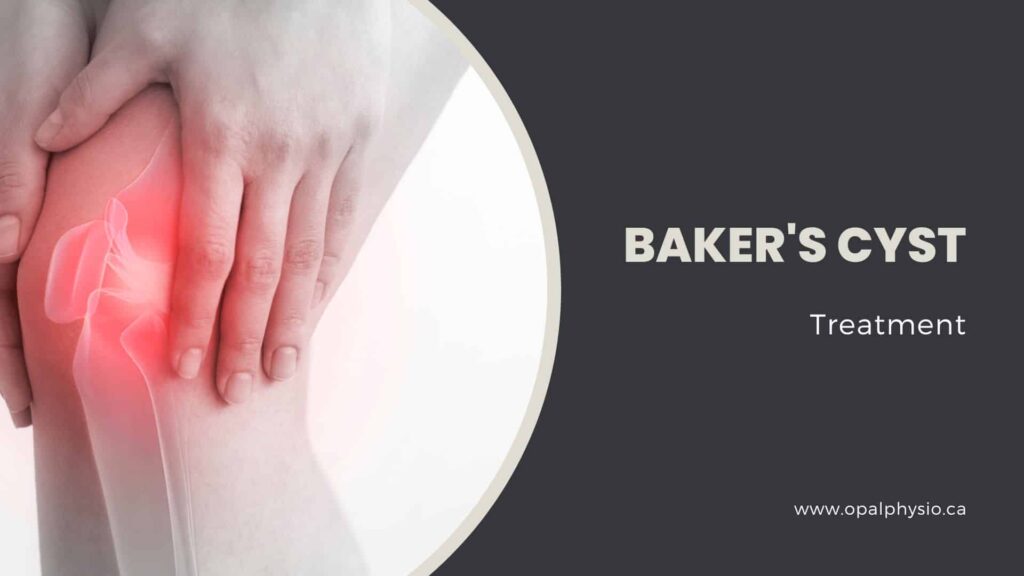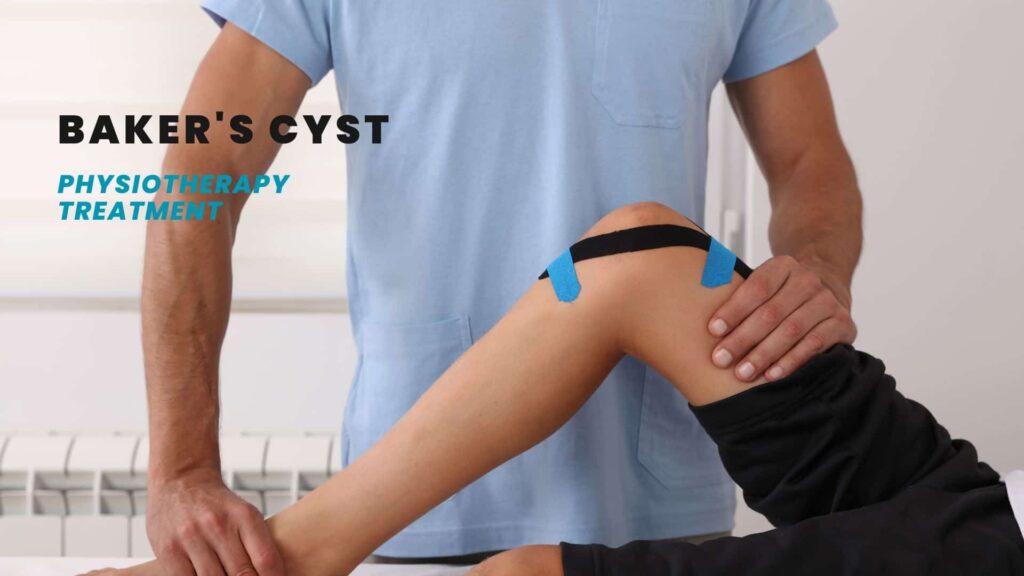Baker’s cyst
A Baker’s cyst is a fluid-filled sac that forms behind the knee. The sac comprises the knee joint’s synovial fluid, which lubricates the joint. Bakers cyst is most commonly seen in people with arthritis in their knees. However, they can also occur in people who have no history of knee problems.
Physiotherapy can help to reduce the pain and swelling associated with a Baker’s cyst. Physiotherapy can also help improve the affected joint’s range of motion and strength.
Our experienced team of physiotherapists is dedicated to helping you find relief from the discomfort and pain caused by this condition.

Symptoms of Baker’s Cyst
The most common symptom of a Baker’s cyst is a bulge and/or a feeling of fullness behind the knee, and it can range in size from a small, pea-sized sac to a large, grapefruit-sized mass. The cyst can sometimes cause the knee to feel stiff and painful.
A Baker’s cyst, also known as a popliteal cyst, is a fluid-filled growth that develops behind the knee. It can cause a bulge and tightness, sometimes leading to pain. The symptoms of a Baker’s cyst may vary, but common ones include:
- Swelling behind the knee and sometimes in the leg.
- Knee pain or pain in the back of the knee.
- Stiffness and inability to fully flex the knee.
- A feeling of fullness or a lump behind the knee.
- Limited range of motion in the knee.
- A build-up of fluid around the knee.
- Occasional locking or clicking in the knee joint.
It is important to note that some people with a Baker’s cyst may not experience any symptoms, and the cyst may only be discovered during a physical exam or diagnostic imaging for another reason.
If you notice any new growth or lump behind your knee, you should visit a healthcare provider for a proper diagnosis and treatment plan.
Causes of Baker’s Cyst
Several factors can contribute to the development of a Baker’s cyst, including:
- Knee arthritis: Osteoarthritis and rheumatoid arthritis can cause the knee joint to produce excess fluid, forming a cyst.
- Meniscus tear: Tearing of the pads of cartilage (menisci) inside the knee can result in excess fluid production and the development of a Baker’s cyst.
- Knee injury: Sports-related injuries, hyperextension injuries, sprains, or dislocations can cause swelling in the knee, leading to a Baker’s cyst.
- Gout: This type of arthritis, which results from the buildup of uric acid in the blood, can lead to a Baker’s cyst.
- Infection: Infections can cause fluid to build up around the knee joint, potentially leading to a Baker’s cyst.
It is important to note that some Baker’s cysts may develop for no apparent reason. Treatment of the underlying cause is essential to prevent the recurrence of a Baker’s cyst.
Treatments for Baker’s Cyst
There are various Baker’s cyst treatment options, which can be categorized into home remedies, medications, physical therapy, and surgery.
Home Remedies
- Apply ice or cold packs to the cyst to reduce pain and swelling.
- Apply heat to the area.
- Rest and elevate the affected leg.
- Use a compression wrap to help reduce swelling.
Medications
- Over-the-counter NSAIDs, such as ibuprofen to help relieve pain and inflammation.
- Corticosteroid injections to reduce inflammation and potentially shrink the cyst.
Physical Therapy
- Exercise to increase the range of motion and strengthen the muscles around the knee.
- Controlled physical therapy programs to improve joint function and help excess fluid drain out of the area.
- Customized exercise programs to address specific needs and symptoms.
Surgery
- Arthroscopic surgery to remove the cyst and repair the knee capsule or synovial lining
- Open surgery to remove the cyst if other treatments have not worked
- Surgery to treat the underlying cause of the Baker’s cyst, such as repairing a meniscus tear or addressing knee arthritis.
It is essential to consult with a healthcare provider to determine the most appropriate treatment plan for your specific situation. They will consider factors such as the severity of the cyst, the underlying cause, and your overall health.

Physiotherapy treatment for Baker’s Cyst
Physiotherapy can help with a Baker’s cyst by addressing the underlying cause, reducing pain, improving joint function, and promoting the drainage of excess fluid. A physiotherapist will evaluate your symptoms and determine what treatment and exercises will help reduce your pain and inflammation.
Physiotherapy can help to manage the symptoms associated with this condition. There are several types of physiotherapy treatment options available for bakers cyst, which includes:
- Soft tissue massage: It can help move fluid for swelling management and reduce tightness.
- Range of motion exercises: These can increase flexibility in the joint and improve knee control. Some exercises that may be helpful include seated hamstring stretches, heel slides, and standing calf stretches.
- Strengthening exercises: Targeting the quadriceps, calf, gluteals, adductors, and hamstring muscles can help offload the knee joint and reduce pain and inflammation. Some exercises that may be helpful include wall squats and side-stepping with resistance bands.
- Manual therapy: Techniques such as mobilization can address joint restrictions and muscle tightness.
- Cryotherapy (ice) and compression: These can help manage swelling.
- Pain and swelling management: Modalities may be used to reduce pain and inflammation, including laser and ultrasound.
- Taping or bracing: This can support the knee and help manage symptoms.
A physiotherapist can design a customized exercise program to help manage the symptoms of a Baker’s cyst and prevent further injury. It is essential to consult with a physiotherapist or healthcare professional before starting any exercise program to ensure the exercises are appropriate for your specific condition.
Why choose us for Baker’s Cyst treatment in Langley?
- Experienced team: Our clinic boasts a team of highly skilled and experienced physiotherapists who specialize in treating Baker’s cyst.
- Patient-centred care: We prioritize your comfort and well-being throughout the treatment process, ensuring that your needs are met every step of the way.
- Evidence-based approach: Our treatments are based on the latest research and evidence in the field of physiotherapy, ensuring that you receive the most effective care possible.
- State-of-the-art facilities: Our clinic is equipped with modern facilities and equipment to provide you with the best possible treatment experience.
At our Langley Physiotherapy clinic, physiotherapists are experienced in treating Baker’s cysts. We will work with you to develop a treatment plan that is right for you. Contact us today to learn more about how physiotherapy can help bakers cyst!
